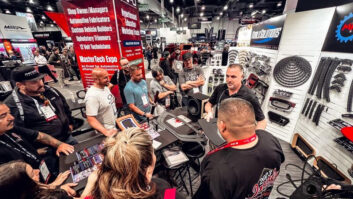
NEW YORK — Many things can happen in five years, so asking analysts to peer a half-decade into the future means we have to take their prognostications with a grain of salt.
That said, TWICE quizzed several industry watchers, asking them what the CE industry will look like and what categories will be driving sales in 2016.
The most popular response was not a surprise: mobile devices. The analysts, and most of those who responded to a similar question on the TWICE 25th Anniversary Survey, all pointed to mobility as being king in 2016.
But just because everyone says so does not necessarily make it a lock.
Stephen Baker, industry analysis VP for The NPD Group, noted that making predictions for technology is a dubious activity at best.
“I think it is impossible to predict what product categories or types will drive the market in five years. After all, if you go back five years, we would not have predicted either netbooks or tablets, we had no iPhone, and 3D and smart TVs were not really on the radar,” he said.
However, Baker was willing to make some general observations, and the first one led right back to the most popular pick.
“Mobile devices, in some shape or form, with some type of connectivity, will dominate the marketplace,” he said, adding that these devices will have even more access to content, without which they are useless.
For Steve Koenig, industry analysis director at the Consumer Electronics Association (CEA), three words describe the future: mobile connected devices.
“These products are carrying the industry now and are pretty much the reason we are hitting a new all-time revenue peak of $190 billion this year,” he said.
Other categories, such as television, are less likely to undergo paradigm shifts over the next half-decade.
Paul Gagnon, DisplaySearch director of North America TV research, pointed out that flat-panel TVs will not be a major income source in the coming years as they continue to become commoditized with fewer new reasons for people to replace their current TV.
“In the end, TVs are a very mature category of CE and unlikely to drive any more revenue growth going forward. The fundamentals are still important, but adding value will continue to be a challenge, especially if other (cheaper) devices can deliver similar benefits,” he said.
Gagnon blamed this situation on the changing face of the TV market and how vendors are trying to control this cycle.
“The TV market was driven by an upgrade cycle, mainly by trading up to a larger size and better picture quality. Only in the last two to three years have innovations focused on something other than these two items, specifically connected TVs, LED backlights in LCD TVs and 3DTVs,” Gagnon said, “All of these are gaining in adoption, but not because consumers are demanding them, but rather because manufacturers and retailers are pushing them.”
Gagnon sees this trend continuing in five years, but with a minor twist. The new features will continue to be a secondary or tertiary reason for buying a new TV, while the old desire for a bigger screen and better picture quality will remain the primary reason people buy something new.
Tamaryn Pratt, principle, Quixel Research, said she is doubtful the TV industry in next five years could possibly contain the same level of innovation that took place over the past decade.
“The market will see incremental changes and feature adoptions,” she said, adding, “Almost all TVs will be connected to the Internet and networked in some way — the convergence of the three Cs [computers, communications and consumer electronics] will finally take over here.”
Other features Pratt sees being incorporated are 4K resolution, the ability of a TV to run apps, and the TV becoming much more PC-like. She expects LCD to drive the market with plasma being marginalized and used primarily for larger screen sizes.
The PC segment will see a different type of change. For the most part, hardware will remain consistent with what is seen now, but content will shift off the device and into the Cloud.
Chris Connery, DisplaySearch’s VP of the PC and large-format commercial display market research group, sees Cloud computing as the focus for the PC industry as hardware vendors look to move away from including larger hard drives, faster processors and more memory in computing devices.
“Local storage and processing power is no longer the game. This has been the cornerstone of personal computing for the last 15 to 20 years in that consumers have been up-sold to new PCs every three to five years in order to get more processing power, better operating system, more storage capacity for their videos, pictures, music, etc.,” he said.
Connery also believes the computing experience will remain very personal as tablet PCs and a developing category that he called a “net or Cloud monitor” keeps the customer connected to the web. He described these devices as having a 30-inch or so screen with just one cable supplying power and connection to the web.
“These Cloud monitors will be ‘smart-monitors’ which will have a big viewable image display and will be stationary — so they might look like an all-in-one PC on the surface — and will connect to the Internet for email, pictures and web browsing,” he said.
Another change for the consumer will be cost. Instead of paying more for hardware, they will instead shell out for Cloud storage.
While taking a gander at what might be coming down the pike is intriguing, so is figuring out which of today’s hot products will fade away.
The Cloud will also play a serious role in pushing some now-popular products onto the back burner.
Koenig noted, “As we move decidedly more toward the Cloud, physical media will begin to yield. This trend seems to be happening faster than we think. Witness the success of streaming media (music and video). iTunes and MP3s have changed how we buy music forever. CDs are passé. Soon Blu-ray, which is enjoying success today, will struggle to stay relevant. Already we have options for 1080p streaming movies via Vudu.”
NPD’s Baker thinks point-and-shoot cameras, MP3 players, DVD, Blu-ray and DVRs will be less important in five years, while accessories and printing will remain strong sales drivers.
Connery does not expect to see a dramatic shift in how people interface with the Internet, particularly for PCs. Voice recognition will not take over from the keyboard, mouse and touchscreen display for all-in-one computers.
Getting ready to replace some of these soon-to-be-relegated to the dust bin of history technologies are others that are just now gaining in popularity.
Koenig sees Internet radio, which has been around for awhile but has remained under the radar, striking it big in the autosound area. Apps for head units are now appearing.
Baker pointed to home automation as possibly being on the brink of experience explosive growth. These will include lighting and health, and will give appliances and devices the ability to tell users how well they are working.
The other impact technology will have centers on how consumers will shop. Again, the impact mobile devices are starting to have on the shopping experience will only increase in five years.
Baker sees the in-store experience becoming even more important, and he stated the current retail shopping experience will be clearly recognizable to any consumer five years down the road.
The major addition will again come via mobile devices, and the role they will play is in gathering pre-purchase data through location services, social media and mobile advertising.
“The in-store experience will remain crucial, if not central, to the consumer’s buying process. Even today, all these new services depend, for the most part, on physical distribution to provide them a marketing partner,” he said.
The CEA is also studying this issue, Koenig said, particularly the impact of consumer’s increasing product knowledge.
“One of the trends we’re talking about now is consumer empowerment. That is, consumers armed with massive retail and pricing intelligence to help them make informed business decisions. This is really pressuring retailers and more sales are going online.”
One downside of the technological jump that will be made in the next five years is it will leave some people behind, said Quixel’s Pratt. This could create a situation where vendors develop and deliver products that will never be understood by a certain segment of the population.
“What will develop in the next five years is a ‘digital ghetto’ for those who struggle to use and understand networked CE products (including their TV) as well as those that cannot afford to connect or afford someone to set up their network,” said Pratt.
The silver lining to this situation is the even greater need for tech services like the Geek Squad, Pratt said.













